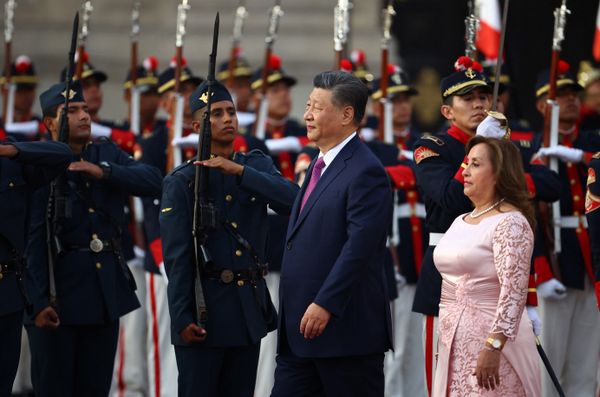LIMA, Nov 15 — Chinese President Xi Jinping arrived in Lima on Thursday, kicking off a week-long diplomatic blitz in Latin America by inaugurating the massive Chancay deep-water port, one of Beijing's most ambitious infrastructure investments in Latin America.
He will participate in the Asia-Pacific Economic Cooperation (APEC) summit in Lima before heading to the Group of 20 summit in Rio de Janeiro next week.
Xi will also conduct state visits to Peru and Brazil, both major sources of metal ores, soybeans, and other commodities that sustain key Chinese industries like electric vehicles and pork, as well as guaranteeing food security for the country's population of 1.4 billion.
His first order of business in Lima is to headline an inauguration ceremony for the Chancay port, along with Peru's President Dina Boluarte.
"Chancay...will revolutionize trade and dynamize the Asia-Pacific economy," Boluarte said in a speech on Thursday at the APEC CEO Summit.
The China-controlled megaport, built by Cosco Shipping Ports and located on Peru's Pacific coast north of Lima, has already drawn US$1.3 billion (RM5.83 billion) in Chinese investment for its first phase, with billions more expected as Beijing and Lima look to turn Chancay into a major shipping hub between Asia and South America.
"We need to jointly build and manage well the Chancay port, make 'from Chancay to Shanghai' truly become a prosperous path to promoting the joint development of China-Peru, and China- Latin America," Xi wrote in an opinion article published on Thursday in the official daily El Peruano.
The Chancay Chamber of Commerce's Peruvian director Mario Ocharan told Reuters that the first ship was due to set sail the week of November 18, transporting Peruvian fruit to China.
He said the real aim of the megaport is access to neighbouring Brazil, where a new railway line will connect the port to Brazilian supplies.
"The Koreans and Chinese have expressed interest in building the railway," Ocharan said.
Cosco Shipping Chancay Peru's corporate affairs manager Mario de las Casas told Reuters that there were still "many connectivity works to be done" and that the entire project would require an investment of US$3.5 billion (RM15.7 billion).
"It is expected that in approximately four years, we could begin to develop the second phase of the project... We are starting now with a movement of one million (containers per year), and with three cranes, we could increase to 1.5 million, and to maintain that volume, it would take about four years to begin the second phase," he said.
De las Casas added that he believes a rail project connecting Chancay to Brazil and its large market is "crucial".
"We have to focus on how to get to Brazil for the mass transport of soybeans. They are the main suppliers of soybeans to China," he said.
[caption id="attachment_379795" align="aligncenter" width="1222"] Chinese President Xi Jinping arrives to attend the Asia-Pacific Economic Cooperation summit, in Lima, Peru, on November 14, 2024. — Picture by REUTERS[/caption]
Chinese President Xi Jinping arrives to attend the Asia-Pacific Economic Cooperation summit, in Lima, Peru, on November 14, 2024. — Picture by REUTERS[/caption]
Geopolitical and economic headwinds
The inauguration of the port comes at a time when Beijing is looking to further tap into the resource-rich Latin American region, amid trade tensions with Europe and concerns about future tariffs from the incoming Trump administration.
Xi is being accompanied by a delegation of over 100 Chinese business executives, including heads of companies with the largest investments in Peru, including Cosco Shipping and mining firm Chinalco, which owns the Toromocho copper mine.
United States (US) Army War College Latin America research professor Robert Evan Ellis said that because Chancay is a fifteen-berth, deep-water port, it will allow for more direct routes between both sides of the Pacific, significantly reducing shipping costs and times.
"In the big war between the global shipping alliances, it really positions Cosco…Chancay illustrates how China seeks secure access to resources and markets and its ever more successful fight to corner global value-added,” he said.
In Xi's opinion article in El Peruano, he pointed out that the Chancay port project would generate US$4.5 billion (RM20.1 billion) in annual revenues, directly create more than 8,000 jobs, and reduce the logistical costs of the route from Peru to China by 20 per cent.
Chancay, China's largest investment in a Latin American port, has raised alarm bells in Washington. Earlier this month shortly before her retirement, former US Southern Command chief General Laura Richardson warned that Chancay could be used by the Chinese military's navy and for intelligence-gathering.
US anxieties about Chancay reflect a broader, decades-long shift in a region known as Washington's backyard that has seen China overtake the US to become the largest trading partner of countries like Peru.
In an editorial published on Monday, China's state-backed Global Times wrote that the port was a "bridge for practical cooperation between China and Latin America and is by no means a tool for geopolitical competition", calling US accusations of the port's potential military use "smears".
Evan Ellis said that the fact Cosco has exclusive use of the port means there is a realistic possibility that it would be used for military purposes in a war.
"This is the Cosco that works hand in hand with the PLA during non-combatant evacuation operations in Yemen and Libya and various other places around the world, so there is no question about the established, expected cooperation with the PLA Navy," he said.
— Reuters
[caption id="attachment_379796" align="aligncenter" width="1320"] Chinese President Xi Jinping arrives to attend the Asia-Pacific Economic Cooperation (APEC) summit, in Lima, Peru, on November 14, 2024. — Picture by REUTERS[/caption]
Chinese President Xi Jinping arrives to attend the Asia-Pacific Economic Cooperation (APEC) summit, in Lima, Peru, on November 14, 2024. — Picture by REUTERS[/caption]




